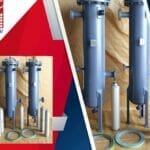Basket strainers play a crucial role in industrial processes by effectively filtering out unwanted particles and contaminants from flowing fluids. We have listed some of the top functionality of basket strainers below:
Filtration Mechanism:
Basket strainers are designed with a perforated or mesh-lined basket-shaped element that traps solid particles while allowing fluids to pass through.
The basket is typically made of materials like stainless steel, brass, or other corrosion-resistant alloys to withstand the harsh conditions of industrial applications.
Debris Collection:
As the fluid passes through the strainer, any solid particles, sediments, or debris that are larger than the perforations in the basket get trapped. This prevents them from moving further downstream.
Ease of Maintenance:
Basket strainers are designed for easy access and maintenance. The removable basket allows for quick cleaning or replacement, ensuring minimal downtime in industrial processes.
Flexibility in Filtration Levels:
Different models of basket strainers offer varying degrees of filtration based on the mesh size or perforation diameter. This allows for customization to suit specific application requirements.
What are the reasons for having basket strainers in industrial processes?
The following are some of the top reasons that we think make it vital to have basket strainers in any industrial setting:
Protection of Downstream Equipment:
One of the primary purposes of basket strainers is to safeguard sensitive equipment downstream, such as pumps, valves, heat exchangers, and meters, from damage caused by abrasive particles or foreign objects.
Maintaining Process Efficiency:
By removing unwanted contaminants, basket strainers ensure that fluids flow smoothly, preventing clogs and blockages that can hinder the efficiency of industrial processes.
Preserving Product Quality:
In industries like food and beverage, pharmaceuticals, and chemicals, maintaining a high level of product purity is essential. Basket strainers help remove impurities, ensuring that the final product meets stringent quality standards.
Extending Equipment Lifespan:
Regular use of basket strainers prolongs the lifespan of equipment by reducing wear and tear caused by abrasive particles. This results in cost savings from reduced maintenance and replacement expenses.
Enhancing System Reliability:
By preventing the entry of contaminants, basket strainers contribute to the overall reliability and uptime of industrial systems. This is critical for industries where continuous operation is crucial.
Compliance with Regulatory Standards:
Many industries are subject to regulatory requirements regarding the quality and cleanliness of their processes. Basket strainers help ensure compliance with these standards.
Mitigating Environmental Impact:
In environmentally sensitive industries, such as wastewater treatment or chemical processing, basket strainers help prevent the release of harmful substances, contributing to a cleaner and safer working environment.
What are the effects of neglected maintenance of basket strainers?
Neglected maintenance of basket strainers can lead to a range of adverse effects, impacting both equipment and overall industrial processes. Here are some of the key consequences:
Reduced Flow Rates and Efficiency:
Accumulated debris and contaminants in a neglected basket strainer can impede the flow of fluid. This can cause reduced throughput and decreased system efficiency along with slower processing time and lower productivity.
Increased Pressure Drop:
As debris accumulates in the strainer, it creates resistance to the flow of fluids. This results in an increased pressure drop across the strainer, which can strain pumps and other components upstream, potentially leading to premature wear and increased energy consumption.
Potential Damage to Downstream Equipment:
Neglected basket strainers allow contaminants to pass through, potentially causing damage to sensitive downstream equipment like pumps, valves, heat exchangers, and other process components. This can lead to costly repairs or replacements.
Risk of System Failures and Downtime:
If a basket strainer becomes severely clogged or fails to function properly due to neglected maintenance, it can lead to unexpected system failures and downtime. This can have significant financial implications for businesses, especially in industries where continuous operation is critical.
Loss of Product Quality and Consistency:
Contaminants that bypass a neglected strainer can compromise the quality and consistency of the final product. This is especially critical in industries like food processing, pharmaceuticals, and chemicals, where product purity is paramount.
Increased Maintenance Costs:
Neglected basket strainers often require more extensive and costly repairs or replacements compared to those that receive regular maintenance. Additionally, the damage caused to downstream equipment can lead to additional maintenance expenses.
Safety Hazards:
In certain industries, neglecting maintenance of basket strainers can lead to safety hazards. For example, in chemical processing, failure to properly filter out hazardous substances can pose risks to workers and the environment.
Environmental Impact:
Debris and contaminants that bypass a neglected strainer may be released into the environment, potentially causing pollution and harm to ecosystems.
Maintenance procedures and best practices of basket strainers
Maintaining basket strainers is crucial to ensure their continued effectiveness in industrial processes. We have listed a few maintenance procedures that can go a long way in ensuring that you get the best out of basket filters:
Regular Inspection:
Conduct routine visual inspections to check for signs of wear, corrosion, and damage to the basket and housing. Look for any deformities or blockages that may impede flow.
Scheduled Cleaning:
Establish a regular cleaning schedule based on the specific requirements of your application. This may range from daily, weekly, to monthly cleanings depending on the type and volume of contaminants filtered.
Basket Removal:
Carefully remove the basket from the housing, taking care not to damage the mesh or perforations. This may require the use of specialized tools or lifting equipment.
Thorough Cleaning:
Use appropriate cleaning agents and methods to remove accumulated debris and contaminants from the basket. This may include soaking, brushing, or using high-pressure water jets.
Inspect Gaskets and Seals:
Check the condition of gaskets and seals for signs of wear, damage, or deterioration. Replace them if necessary to maintain a proper seal and prevent leakage.
Examine Housing Interior:
Inspect the interior of the housing for any buildup of debris or contaminants. Clean and remove any residue to ensure unimpeded flow.
Replace Worn or Damaged Parts:
If any components, such as the basket, gaskets, or seals, show signs of significant wear or damage, they should be replaced promptly to maintain the strainer’s effectiveness.
Verify Proper Reassembly:
When reassembling the basket strainer, ensure that all components are properly aligned and secured. Pay special attention to the correct positioning of gaskets and seals.
Documentation and Record-keeping:
Keep detailed records of maintenance activities, including dates, procedures performed, and any replaced components. This helps establish a maintenance history for future reference.
Training and Education:
Ensure that personnel involved in maintenance activities are properly trained on the specific procedures and best practices for maintaining basket strainers.
By utilizing the benefits of basket strainers, companies can elevate their filtration performance, setting the stage for operational success. Sungov Engineering recognizes the crucial role of effective industrial filtration.
Embrace the potential of duplex basket strainers and witness the substantial improvements they bring to industrial filtration. Contact our engineers today to explore how we can enhance your process.




